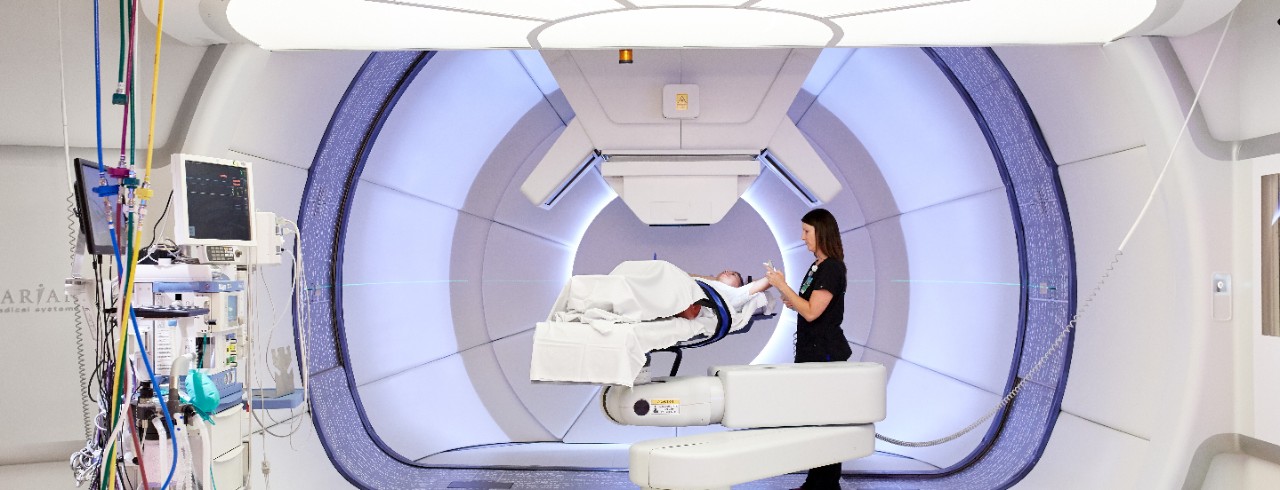
Study: Time is of the essence when saving skin during FLASH radiotherapy
A study shows that intervals in beam treatment decrease the skin-saving aspects of the procedure
A published study by researchers at the University of Cincinnati Cancer Center and Cincinnati Children’s shows that multiple beams and intervals in delivery during FLASH proton therapy treatment reduced skin-saving effects in preclinical models.
The study was published in the International Journal of Radiation Oncology, Biology, Physics.
FLASH is an experimental mode of delivering radiation therapy for cancer that can be delivered to a patient in less than one second and which can be over 100 times faster than conventional radiation therapy.
Research in the laboratory suggests that FLASH may be safer than standard forms of radiation and, in many cases, causes fewer side effects, including irritation or burning of the skin.

Mathieu Sertorio, PhD, corresponding author and a member of the basic science research program within the University of Cincinnati Cancer Center. Photo/Provided by Sertorio.
“FLASH proton pencil-beam-scanning has shown a reduction in skin toxicity for preclinical models when delivered in a single, uninterrupted high dose,” says Mathieu Sertorio, PhD, corresponding author on the paper and a member of the basic science research program within the Center. “However, for treatment of patients, multiple beams are required to diminish the exposure of normal tissue to radiation and to make sure the entire area identified for treatment is targeted. The administration of these beams are separated by minutes to allow patient and equipment repositioning.”
In this study, researchers from the center delivered a particular radiation dose of FLASH radiotherapy in either a single or multiple beams in one area of a model and observed skin tissue over the course of 16 weeks at the Cincinnati Children’s/University of Cincinnati Medical Center Proton Therapy Center. This proton therapy center has the only research-dedicated room in the world.
“The treatment was delivered as one, two or three equal beams with an interruption of two minutes simulating the clinical experience of patients,” explained Sertorio.
Sertorio says that the single beam delivery showed a maximum benefit to skin, but when it was interrupted for two minutes and then readministered in the same area, it reduced the FLASH skin-saving effect. After two interruptions, the skin tissue-sparing effect was further eliminated.
“Our results indicate that the FLASH skin-sparing effect in areas of beam overlap were diminished by multiple beams as opposed to single beams,” he says. “This study suggests the number of beams and the spatial arrangement of those beams are important parameters for FLASH studies. Furthermore, the effect of multibeam delivery is likely different for different organs of interest.”
"This study is important because it informs the clinical translation of FLASH radiotherapy, with respect to beam delivery modalities, treatment planning and radiation prescriptions,” says co-author Anthony Mascia, PhD, of Cincinnati Children’s. “We need to identify where FLASH works and where FLASH doesn't work to move forward."
Innovation Lives Here
The University of Cincinnati is leading public urban universities into a new era of innovation and impact. Our faculty, staff and students are saving lives, changing outcomes and bending the future in our city's direction. Next Lives Here.
This research was funded by Varian, a Siemens Healthineers company. Sertorio, as well as co-investigators Mascia and John Perentesis, MD, from Cincinnati Children’s report research grants from Varian.
Featured photo of radiation therapist situating someone in one of the gantries at the Proton Therapy Center. Photo/Cincinnati Children's.
Related Stories
UC Day of Giving a success
April 28, 2021
University of Cincinnati Day of Giving’s 24-hour challenge was a tremendous success this year, raising $2,219,197 with 3,232 gifts. The fourth annual UC Day of Giving raised its most money to date with alumni, donors, students, faculty and staff joining together to support UC and UC Health.
President picks exceptional talent
April 28, 2021
The University of Cincinnati 2021 Presidential Leadership Medal of Excellence Awards honor six undergraduate scholars for scholarship, leadership, character, service and the ideals of the university. Awardees are spotlighted for exceptional academics, creativity, community service and innovation.
Grad students earn president's highest honor
April 28, 2021
The University of Cincinnati 2021 Presidential Medal of Graduate Student Excellence Awards honor three graduate scholars for scholarship, leadership, character, service and the ideals of the university. Awardees are spotlighted for exceptional academics, creativity, community service and innovation.
Local 12: 180 UC med students receive white coats, students embark on journey during pandemic
August 9, 2021
The University of Cincinnati College of Medicine welcomed 180 newly admitted first-year students during the college’s 26th annual White Coat Ceremony. The ceremony was held Friday at 10 a.m. at Cincinnati Music Hall, 1241 Elm Street. Each member of the class of 2025 were presented with a white lab coat, symbolizing entry into the medical profession. Local 12 covered the event.
Finding community and building a future
July 9, 2021
As a University of Cincinnati College of Medicine student, Sarah Appeadu, MD, ’21, remembers journaling on the “3 Cs” that got her through medical school: Community, community, community. Now, when she lists the people who supported her through four years of training—the last year in a global pandemic—it keeps growing: her family, her church, her classmates, and the college’s Office of Student Affairs and Office of Diversity, Equity and Inclusion. “I look back and it was such a crucial time to really be nurtured in that way,” she says. “I’m so thankful that I had those people. It shows being around the right people really mattered. That’s my same hope for residency even.”
UC to honor 2,079 grads at summer Commencement
August 2, 2021
UC celebrates the 2021 summer Commencement on Friday in two ceremonies at Fifth Third Arena. On Saturday, UC will recognize 2020 grads with an in-person Commencement celebration.
New York Times: Flint Weighs Scope of Harm to Children Caused by Lead in Water
February 1, 2016
Kim Dietrich, a professor of environmental health at UC's College of Medicine, is quoted in this story on the medical problems that could develop among the thousands of young children exposed to lead-contaminated water in Flint, Mich.
Cancer-Causing Gene Found in Plasma May Help Predict Outcomes for Patients
February 18, 2016
Researchers at the University of Cincinnati have discovered that a human cancer-causing gene, called DEK, can be detected in the plasma of head and neck cancer patients.
UC Receives $1.9 Million to Study Pain
February 15, 2016
Jun-Ming Zhang, MD, of the UC College of Medicine, is the principal investigator of a $1.95 million grant to study the interacting roles of the sympathetic and sensory nervous and immune systems in back and neuropathic pain models.
MD Magazine: Generic Drug Equally Effective in Epilespy
February 22, 2016
Michael Privitera, MD, a professor of neurology at UC's College of Medicine and director of the Epilepsy Center at the UC Neuroscience Institute, is featured in this story about research he led that examined the efficacy of generic drug substitution for epilepsy.
